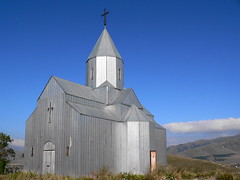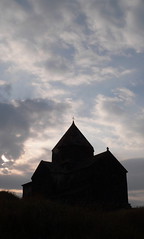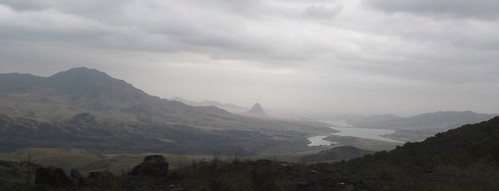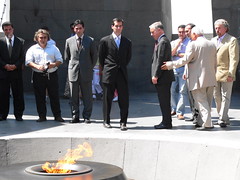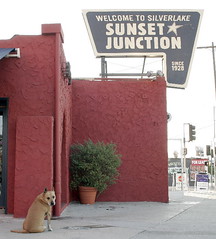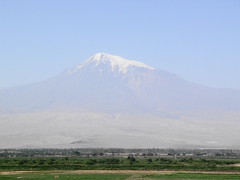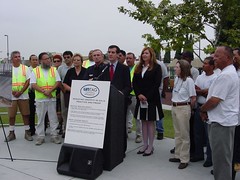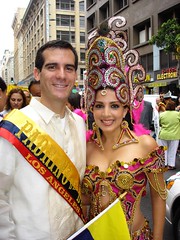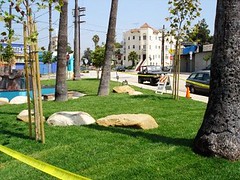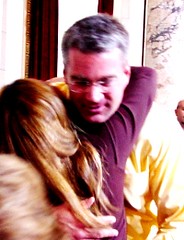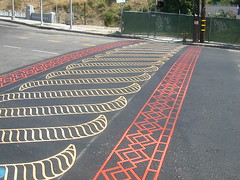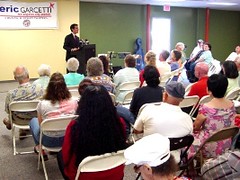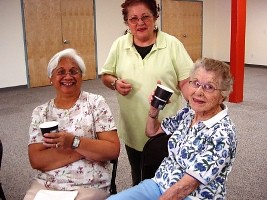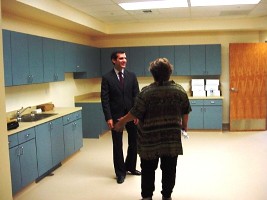Tuesday, August 30, 2005
Sister Cities at last!
Posted by
lacityorgcd13
at
3:34 PM
Hollywood in Yerevan
For a city surrounded on three sides by hills, the days linger for a surprisingly long time. It stays light until almost nine o'clock at night. On Thursday night, we went to the Artbridge Café for a Café Glasse (iced coffee with ice cream) and a bite to eat. There is a very vibrant contemporary art scene in Yerevan; Artbridge sells some excellent art for about a tenth the price of what it might go for in an Echo Park gallery. The café was sprinkled with Yerevan hipsters, students, and artists. I spotted a young Armenian woman who pulled off a surprising look, combining a sky-blue Britney Spears top hat with a Paris Hilton-style handbag-sized dog.
On the way back, we saw small crowds of people on each of the four street corners of our hotel's intersection. I saw two cars in the middle of the street and suspected a car accident, but we soon saw that the intersection was closed off for film proudction. The Yerevan Film Studios were shooting what looked like a music video. (This was only half a block from the Hollywood Casino.)
One of the top projects that we have explored for possible collaboration between Los Angeles and Yerevan is between the city's respective film industries. One member of our delegation is talking to the Armenian government about the possible establishment of an Armenian Film Commission. The U.S. Embassy is involved with a project to restore valuable but deteriorating film archives here in Yerevan, which was an important locus of filmmaking in the early days of the medium. And the Silver Lake Film Festival asked me to keep my eyes out for new Armenian films that might be shown at next year's festival. I'm seeking other contact points for film exchange, too. Perhaps AFI or some other entity could connect to the restoration project, and I'd like to see if equipment donations could be arranged between studios and post-production facilities in L.A. and their Armenian counterparts.
Posted by
lacityorgcd13
at
3:13 PM
Garni, Geghard, and Zara's Terrific Sandwich
Garni Temple and Geghard Monastery both deserve entries in their own right, but until I have the chance to blog them properly, I'll refer you to their Armeniapedia links. Our real accomplishment of the day was when, hungry from touring, we came up short for lunch options, and our guide Zara and her young aunt Getzmadzin put together an impromptu post-tour feast for us. We all came back to their house, where Zara dipped next door to negotiate some home-made yogurt and cheese from her neighbors while Getzmadzin picked some choke cherries, black currants, and plums for us to try. One of the country's ever-present sweet and juicy watermelons was produced and quickly divided, and some fresh honey put out as well. The lavash was still warm as we greedily scooped up the yogurt and honey. Zara recommended combining the mild, feta-like cheese made from the neighbor's cow with the watermelon wrapped in the lavash for a swee-and-salty sandwich. It would have been rude for us not to take a bit of cognac, too, so we did so to chase down the stunning meal. Thanks, Zara and Getzmadzin!
Posted by
lacityorgcd13
at
2:34 PM
Earthquake Town
Foreign assistance helped rebuild Spitak. As you drive through the town, you see that one of the best-kept and newest cities in Armenia has emerged from the tragedy.
We stopped at a church built in the Armenian traditional style, with one exception. Draped in uncharacteristic steel siding, the church was erected in about 45 days. The accelerated timetable was necessary to accommodate the thousands of funerals for Spitak's earthquake dead. Surrounding the church are tombstones in the traditional Soviet style, with pictures of the deceased etched into the stone (a feature now seen widely in Los Angeles, for example at the Hollywood Forever cemetery in CD13). The church is now abandoned, with a rusty lock that looks like it hasn't been opened in years. Like much of Armenia, Spitak would rather look to the future than back at the sadness of its past.
Posted by
lacityorgcd13
at
2:26 PM
Lake Sevan
We drove through Ijevan and enjoyed a stiff cup of Armenian coffee before departing the city where the Soviet Army first entered Armenia in 1920. Passing close to the Azerbaijan border on our way, we saw some burned-out villages that had been Azeri exclaves in Armenia, bringing to mind the war that shook this idyllic landscape and did not now seem so distant.
We crossed the border into the Republic of Georgia just after a motorcade that included the Georgian Defense Minister (who was on his way to visit his Armenian counterpart) crossed in the opposite direction.
Posted by
lacityorgcd13
at
2:04 PM
The Eternal Flame
And like many memorials, it is no less moving for its lack of adornment. The memorial features an eternal flame surrounded by twelve obelisks. The obelisks symbolize the twelve historical population centers the Armenian people. Together, Governor Dean and I planted a pine tree in a grove where elected officials from around the world have done the same in remembrance of the genocide.
Onnik Krekorian's links have more about our visit to the memorial.
Posted by
lacityorgcd13
at
1:40 PM
Friday, August 26, 2005
Meanwhile, back in Los Angeles ...
Posted by
lacityorgcd13
at
4:59 PM
The First Christian Nation
Our delegation went down into the pit, which has been preserved all of these years. A 17th century church (very modern by Armenian standards) sits atop the pit, but on a summer day, it is a pretty miserable place to be. Thirteen years down there is unimaginable.
The Armenian Church is neither Eastern Orthodox nor Catholic, but is a separate branch of Christianity with its own Catholicos (or pope) and liturgy. Saint Mesrop developed the Armenian alphabet in order to spread the Christian Gospels to Armenian-speakers. This was the first of many ancient sites we are to visit, in a country where a 12th or 13th century church is hardly old. Meeting with the mayor of Yerevan the day before, I told him that Los Angeles would celebrate its 224th birthday in two weeks, to which he replied that Yerevan celebrates its 2768 birthday this year. Kind of puts things in perspective.
Posted by
lacityorgcd13
at
2:09 PM
The Two Largest Armenian Cities Meet (L.A. and Yerevan)
We visited Mayor Zakharyan in the gleaming new Yerevan City Hall, one of the most beautiful buildings in the city. The mayor agreed to sign the agreement to form a Sister City relationship with Los Angeles. We spoke about emerging industries in Yerevan and throughout Armenia and about links to with Los Angeles companies. We looked at cooperation on the issues of law enforcement: a criminal wanted by the LAPD was arrested in Armenia just before we arrived. And we explored possible cooperation around seismic standards for buildings, considering we both live with fault lines in and around our cities. The State of California is establishing a trade office in Yerevan, and we are looking at possibly co-locating our Sister City initiative with them in order to enhance some of their economic projects in Armenia.
It was a very productive day, and tough too—these meetings all took place between about 11PM and 5AM Los Angeles time. We had a great meal at an outdoor restaurant alongside the river with officials and our hosts and took in some jazz in one of Yerevan's vibrant outdoor cafés before calling it a night.
Posted by
lacityorgcd13
at
1:47 PM
More Armenia pics and a note on the chronology
I've been shooting a good deal of pictures from Armenia, more than I am posting directly on to the blog. You can see my Armenia photo set here and watch it as a slideshow here.
Also, please know that as connected as I am, there is something of a time lag between my trip and my blogging. If a lot of posts all show up at once, they are probably drawn from events of a few days in a row. I'll try to keep you as updated as possible, do the work I came to do and enjoy the trip as well. Enjoy!
Posted by
lacityorgcd13
at
1:34 PM
Approaching Ararat
That Ararat now sits across the Turkish border makes this mountain also a symbol for the lost culture of Western Armenia. With few exceptions, Turkey prohibits tourists from traveling to the mountain. Cut away from the nation's boundaries, the mountain is as unreachable and omnipresent as a phantom pain, standing in for the suffering of Armenia's last 120 years. The poetry, music, and culture of the past invoke its greatness, while the current situation reminds the Armenian nation of its lost glories.
We visit Ararat tomorrow.
Posted by
lacityorgcd13
at
1:21 PM
Wednesday, August 24, 2005
Bus benches on Riverside
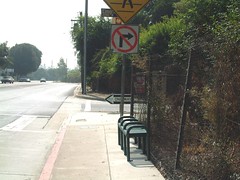
Posted by
lacityorgcd13
at
11:14 AM
Tuesday, August 23, 2005
More from Armenia

Onnik Krekorian left some useful links to posts about our trip on the Oneworld Multimedia Blog in the comments section at my personal blog. See "Dean Vows Support For Genocide Recognition" and "Yerevan and Los Angeles To Become Twin Cities?". In the photograph (by Mr. Krekorian), I joined Governor Dean and Giro Manoyan from the Armenian National Committee in Tsitsernakaberd, Yerevan to plant a tree in memory of the 1.5 million Armenians who perished in the Armenian genocide.
Posted by
lacityorgcd13
at
9:57 AM
Monday, August 22, 2005
Halfway around the world
Cross-posted from ericgarcetti.org/blog.
(this is my first entry, which I am typing in from a hotel room in Tbilisi, Georgia--it is my first handy internet connection when I have had a moment to come up for air. I am in Georgia for two days, but returning to Armenia later today, where I hope to download some photos and write a couple more entries that cover the first three days in Armenia--check out the comments section of the last posting for some links that others have put on the blog.)
On early Friday morning, after an exhausting 23 hours of travel, we touched down exactly halfway around the world from Los Angeles in Yerevan, Armenia. (Since Yerevan is twelve time zones from Los Angeles, I didn't have to change the time on my watch!). At the airport, a television camera waited for us until 3 in the morning, and there was a table set out with fresh fruit and cognac (I opted for the former, considering the hour). While British Airways lost two pieces of our party's luggage, we were mostly intact. I did a quick interview with the television camera bringing greetings from the world's second-largest Armenian city—Los Angeles—and setting out our trip's goal of establishing a Sister City relationship with Yerevan. It was no easy feat after almost a day of travel.
The Yerevan airport is an architectural marvel—it is like a giant octagonal beehive, with arrivals in the center and departures leaving from above. Built in Soviet times, it is a cement sculpture. The airport is currently expanding and the operations are being handed over to a foreign company in an ongoing wave of privatization.
On the way into town, we saw many casinos with names like Caesar's and Hollywood Casino, which we learned have been banished from the city center to the outskirts of town. On the road from airport, they have formed a kinda Yerevan Strip. We also passed the brand-new American embassy, built on one of the biggest pieces of land of any American embassy abroad. It was impressive.
We drove through the city center in the waning hour of the night, but its stateliness was easily apparent—a seemingly well-planned center, with a real European feel. There were cafes everywhere, some folks were still out at 4am roaming the wide boulevards, and there was a video screen up where the statue of Lenin once stood in the main square.
We settled into our hotel and prepared for the next day's meetings with government officials and Yerevan representatives.
Posted by
lacityorgcd13
at
9:33 PM
E-news for August
August's e-News has been sent out and is available online. If you didn't receive it by e-mail, why not sign up today? Regular readers of the blog will be familiar with some of the updates, but there's always more news in the e-news than makes the blog, especially in your neighborhood.
As for the blog itself, posting may be light for the next two weeks. Council is on recess, and I am traveling. More on that in the next post...
Posted by
lacityorgcd13
at
11:34 AM
Thursday, August 18, 2005
Support the Atwater Village Farmer's Market
Posted by
lacityorgcd13
at
5:21 PM
Tuesday, August 16, 2005
CD13 is UNTAGged!
I had been inspired by the example of Ron Gonzales, the mayor of San Jose, CA, who had remarkable successes lowering graffiti in San Jose. However, when my staff spent a day driving CD13 block by block to count tags, we found densities of up to ten times the graffiti found in San Jose. Still, we had our base number (20,763 tags in the 13.13 square miles of CD13) and we knew what we had to do to bring that number down.
The key to our success was our recruitment of block captains. Starting with the thirty or so people who signed up at our kickoff, we reached 100 block captains, people who took responsibility for reporting any instances of graffiti to our paint-out crews, either by calling our office directly or by using 3-1-1. We also won funding for security cameras (PDF) to be placed in parks such as Lake Street Park, whose brand new skate park, recreation center and playground had all been marred by acts of vandalism in the first months of its young existence. A year after our initial benchmark count—a year in which constant, block-captain-driven graffiti reporting had substantially increased the workload for our paint-out crews, Central City Action Coalition and Hollywood Beautification Team—my staff and I drove the district once again, counting tags with the same methodology we had used a year before. The results were astonishing. The entire day turned up only 7,970 tags: a 62% reduction in only one year.
Jocelyn Geaga-Rosenthal, a block captain from Historic Filipinotown, captured it best at the press conference announcing the results when she said, "Fighting graffiti is like brushing your teeth. You have to do it every day to see results." She added: "But now my neighborhood has a great big smile." UNTAG did the job with neighbors' engagement, smart police work, and real care. Let's keep up the momentum of reducing graffiti. Won't you become a block captain (PDF) today?
Posted by
lacityorgcd13
at
3:32 PM
Ecuadorian Independence Parade
Posted by
lacityorgcd13
at
3:25 PM
National Night Out in Glassell Park

Posted by
lacityorgcd13
at
3:07 PM
Monday, August 08, 2005
Electeds Blog
Governing magazine has an interesting article about blogs in the Texas statehouse. In addition to the political commentators who keep an eye on the Legislature from their computers or even from the visitors' gallery, I noticed that Texas State Representative Aaron Peña writes A Capitol Blog. He joins California's Assemblymember Paul Koretz as electeds with blogs (he and Koretz even share the same template. What are the odds?). Are there any other elected officials whose blogs you read?
Posted by
lacityorgcd13
at
1:12 PM
Thursday, August 04, 2005
Turf's up!
Posted by
lacityorgcd13
at
12:23 PM
Wednesday, August 03, 2005
CD13.com improvements
I've made a few changes to the blog, and there may be a few more in store. Council-Blog v1.0 was a breakthrough for the lacity.org website, but it still lacked some elementary features of blogs, namely permalinks and a feed. I am pleased to announce that both are now in our repertoire. To subscribe to cd13.com posts, use this link in your news aggregator. (For an explanation of feeds and news aggregators, this Wikipedia entry is helpful. A feed allows you to be notified when I post a new entry, instead of having to keep checking the website every other hour.)
Thank you to the crew at ITA's Webservices division for putting the new system together by capturing content from an existing blogger.com website. The whole team had a hand in it, including Joe Quan, Bob Hill, Virginia DePrez, Hoa Nguyen, Jess Kapik Chong, Dominic Degrassi, Jason Nishi and Hans Pravecek. I'm told they're hard at work on a blogging platform that will be entirely in-house; in the meantime, thanks for giving me new ways to communicate with CD13.
Posted by
lacityorgcd13
at
5:06 PM
Tuesday, August 02, 2005
The Staff of Housing, Community and Economic Development
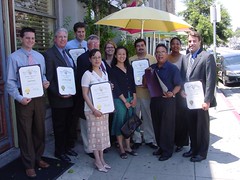
The Housing, Community and Economic Development committee is no walk in the park. With oversight over the Housing Department, the Community Development Department and the Community Redevelopment Agency, the committee I chair must process hundreds of transmittals from those three departments and several others over the course of a year. The work includes approving city economic development projects, putting new affordable housing in the ground, issuing tax-exempt bonds, and helping fund non-profit organizations that serve at-risk youth, low-income families, and seniors; in addition to handling those individually, we have to set the overarching city policies that guide the conception and creation of those projects. To keep up, we meet once a week (most committees meet twice a month). And every decision that the committee makes is informed by the hard work of the staffs of the Chief Legislative Analyst and the City Administrative Officer, assisted by the City Attorney and City Clerk.
To show our appreciation for this heroic but unrecognized effort, I invited the whole crew to join me for a mellow ceremonial lunch in Silver Lake. Thank you! From left: Todd Bouey (CAO), Neil Blumenkopf (CA), John White (Clerk), Angelica Samayoa (CAO), Paul Smith (CLA), Meg Barclay (CLA), Bea Hsu from my own staff, Emilio Rodriguez (CAO), Robert Andrade (CAO), Lisa Johnson-Smith (CAO), Scott Eritano (CAO). Not pictured: Ivania Sobalvarrio (CLA).
Posted by
lacityorgcd13
at
5:42 PM
Adios, Glen
Posted by
lacityorgcd13
at
5:27 PM
Crosswalks in Hi-F
UPDATE: Thanks to Congressmember Xavier Becerra's good work on appropriations matters, the streetscape project has been funded with an additional $400,000. And Congressmember Becerra also won CD13 $1.12 million for badly needed street lighting in Elysian Valley. Thank you!
Posted by
lacityorgcd13
at
5:20 PM
Stan Chambers
Posted by
lacityorgcd13
at
5:14 PM
Public Space at Public Storage
After a rocky start in the community, Public Storage has become a great neighbor. When it wanted to change its operations, it sought community input as to how it could help the community as it shifted from an underutilized drop-off facility to a typical storage center. With great participation from local groups facilitated by my deputy Mitch O'Farrell, the vision for the multi-purpose center took shape.
The Glassell Park Seniors were tired of having to play an inadvertent dodgeball game with local youth everytime they met next door at the recreation center. There weren't enough parking spaces or meeting rooms at that center to meet the growing community's needs. All these concerns factored into the design that has now been realized in a state-of-the-art public space where our the vital grass-roots organizations that make our democracy hum can meet, plan or argue the shape of their neighborhoods and our lives.
Public Storage has given us the space for a 30-year, $1-annual lease. We'll make the most of it.
Posted by
lacityorgcd13
at
2:27 PM
Monday, August 01, 2005
UNTAG one year later
A year ago, in preparation for the debut of my graffiti-fighting initiative UNTAG, I spent the day with my entire city hall and field staff driving every block of the 13th District, counting tags on buildings, sidewalks, utility boxes and nearly every visible space. On a single day in July, we counted 20,763 tags; that would be the benchmark against which we would gauge our success. A week later, I gathered with community leaders, volunteers, Chief Bratton and Public Works Commissioner Cynthia Ruiz to vow that we would cut the amount of graffiti in CD13 in half within two years.
On Thursday, my staff and I went out into the field again, using the same counting methodology we used last time. Once the results are in and processed, we'll announce how far we've progressed towards our graffiti-reduction goal. My fingers are crossed. Stay tuned!
Posted by
lacityorgcd13
at
4:13 AM


